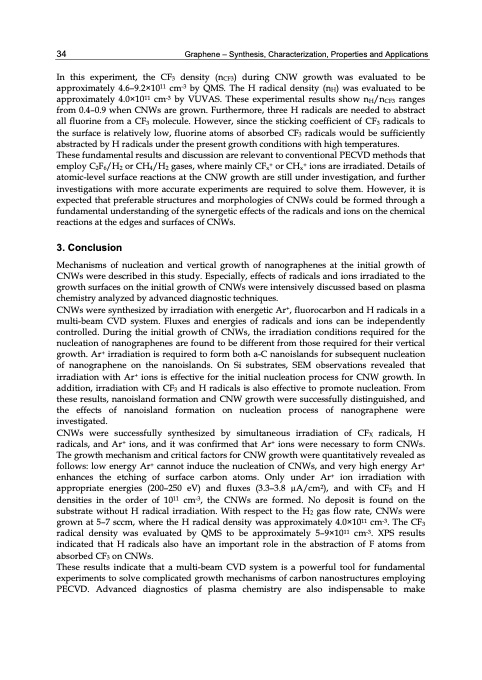
PDF Publication Title:
Text from PDF Page: 044
34 Graphene – Synthesis, Characterization, Properties and Applications In this experiment, the CF3 density (nCF3) during CNW growth was evaluated to be approximately 4.6–9.2×1011 cm-3 by QMS. The H radical density (nH) was evaluated to be approximately 4.0×1011 cm-3 by VUVAS. These experimental results show nH/nCF3 ranges from 0.4–0.9 when CNWs are grown. Furthermore, three H radicals are needed to abstract all fluorine from a CF3 molecule. However, since the sticking coefficient of CF3 radicals to the surface is relatively low, fluorine atoms of absorbed CF3 radicals would be sufficiently abstracted by H radicals under the present growth conditions with high temperatures. These fundamental results and discussion are relevant to conventional PECVD methods that employ C2F6/H2 or CH4/H2 gases, where mainly CFx+ or CHx+ ions are irradiated. Details of atomic-level surface reactions at the CNW growth are still under investigation, and further investigations with more accurate experiments are required to solve them. However, it is expected that preferable structures and morphologies of CNWs could be formed through a fundamental understanding of the synergetic effects of the radicals and ions on the chemical reactions at the edges and surfaces of CNWs. 3. Conclusion Mechanisms of nucleation and vertical growth of nanographenes at the initial growth of CNWs were described in this study. Especially, effects of radicals and ions irradiated to the growth surfaces on the initial growth of CNWs were intensively discussed based on plasma chemistry analyzed by advanced diagnostic techniques. CNWs were synthesized by irradiation with energetic Ar+, fluorocarbon and H radicals in a multi-beam CVD system. Fluxes and energies of radicals and ions can be independently controlled. During the initial growth of CNWs, the irradiation conditions required for the nucleation of nanographenes are found to be different from those required for their vertical growth. Ar+ irradiation is required to form both a-C nanoislands for subsequent nucleation of nanographene on the nanoislands. On Si substrates, SEM observations revealed that irradiation with Ar+ ions is effective for the initial nucleation process for CNW growth. In addition, irradiation with CF3 and H radicals is also effective to promote nucleation. From these results, nanoisland formation and CNW growth were successfully distinguished, and the effects of nanoisland formation on nucleation process of nanographene were investigated. CNWs were successfully synthesized by simultaneous irradiation of CFX radicals, H radicals, and Ar+ ions, and it was confirmed that Ar+ ions were necessary to form CNWs. The growth mechanism and critical factors for CNW growth were quantitatively revealed as follows: low energy Ar+ cannot induce the nucleation of CNWs, and very high energy Ar+ enhances the etching of surface carbon atoms. Only under Ar+ ion irradiation with appropriate energies (200–250 eV) and fluxes (3.3–3.8 μA/cm2), and with CF3 and H densities in the order of 1011 cm-3, the CNWs are formed. No deposit is found on the substrate without H radical irradiation. With respect to the H2 gas flow rate, CNWs were grown at 5–7 sccm, where the H radical density was approximately 4.0×1011 cm-3. The CF3 radical density was evaluated by QMS to be approximately 5–9×1011 cm-3. XPS results indicated that H radicals also have an important role in the abstraction of F atoms from absorbed CF3 on CNWs. These results indicate that a multi-beam CVD system is a powerful tool for fundamental experiments to solve complicated growth mechanisms of carbon nanostructures employing PECVD. Advanced diagnostics of plasma chemistry are also indispensable to makePDF Image | GRAPHENE SYNTHESIS CHARACTERIZATION PROPERTIES

PDF Search Title:
GRAPHENE SYNTHESIS CHARACTERIZATION PROPERTIESOriginal File Name Searched:
Graphene-Synthesis.pdfDIY PDF Search: Google It | Yahoo | Bing
Salgenx Redox Flow Battery Technology: Power up your energy storage game with Salgenx Salt Water Battery. With its advanced technology, the flow battery provides reliable, scalable, and sustainable energy storage for utility-scale projects. Upgrade to a Salgenx flow battery today and take control of your energy future.
| CONTACT TEL: 608-238-6001 Email: greg@infinityturbine.com | RSS | AMP |